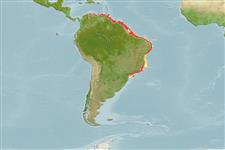>
Eupercaria/misc (Various families in series Eupercaria) >
Haemulidae (Grunts) > Plectorhinchinae
Etymology: Genyatremus: Greek, geny, -yos = face, jaw + Greek, trema, = aperture (Ref. 45335).
More on author: Bloch.
Environment: milieu / climate zone / depth range / distribution range
Ökologie
seewasser; brackwasser demersal; tiefenbereich ? - 40 m (Ref. 9626). Tropical; 30°N - 33°S, 97°W - 32°W
Western Atlantic: Lesser Antilles, Colombia to Brazil.
Size / Gewicht / Alter
Maturity: Lm ? range ? - ? cm
Max length : 37.0 cm TL Männchen/unbestimmt; (Ref. 9626); common length : 25.0 cm TL Männchen/unbestimmt; (Ref. 5217); max. veröff. Gewicht: 800.00 g (Ref. 5217)
Rückenflossenstacheln (insgesamt) : 13; Rückenflossenweichstrahlen (insgesamt) : 12; Afterflossenstacheln: 3; Afterflossenweichstrahlen: 11.
Mainly found in brackish estuaries and adjacent areas, over sandy or muddy bottoms. Sometimes caught in marine waters. Feeds on crustaceans (Ref. 3798). Marketed fresh (Ref. 3798).
Life cycle and mating behavior
Maturities | Fortpflanzung | Spawnings | Egg(s) | Fecundities | Larven
Distinct pairing during breeding (Ref. 205).
Cervigón, F., R. Cipriani, W. Fischer, L. Garibaldi, M. Hendrickx, A.J. Lemus, R. Márquez, J.M. Poutiers, G. Robaina and B. Rodriguez, 1992. Fichas FAO de identificación de especies para los fines de la pesca. Guía de campo de las especies comerciales marinas y de aquas salobres de la costa septentrional de Sur América. FAO, Rome. 513 p. Preparado con el financiamento de la Comisión de Comunidades Europeas y de NORAD. (Ref. 5217)
IUCN Rote Liste Status (Ref. 130435)
Bedrohung für Menschen
Harmless
Nutzung durch Menschen
Fischereien: weniger kommerziell
Tools
Zusatzinformationen
Download XML
Internet Quellen
Estimates based on models
Preferred temperature (Ref.
123201): 23.5 - 28, mean 26.7 °C (based on 330 cells).
Phylogenetic diversity index (Ref.
82804): PD
50 = 0.5625 [Uniqueness, from 0.5 = low to 2.0 = high].
Bayesian length-weight: a=0.01778 (0.01068 - 0.02961), b=2.96 (2.82 - 3.10), in cm total length, based on LWR estimates for this species & (Sub)family-body (Ref.
93245).
Trophic level (Ref.
69278): 3.5 ±0.50 se; based on food items.
Widerstandsfähigkeit (Ref.
120179): mittel, Verdopplung der Population dauert 1,4 - 4,4 Jahre. (Preliminary K or Fecundity.).
Prior r = 0.55, 95% CL = 0.36 - 0.83, Based on 1 data-limited stock assessment.
Fishing Vulnerability (Ref.
59153): Low to moderate vulnerability (27 of 100).
Nutrients (Ref.
124155): Calcium = 124 [33, 256] mg/100g; Iron = 1.01 [0.54, 2.01] mg/100g; Protein = 18.3 [16.4, 20.3] %; Omega3 = 0.18 [0.08, 0.35] g/100g; Selenium = 46.5 [23.6, 91.3] μg/100g; VitaminA = 14.5 [5.5, 37.1] μg/100g; Zinc = 1.2 [0.8, 1.8] mg/100g (wet weight);
